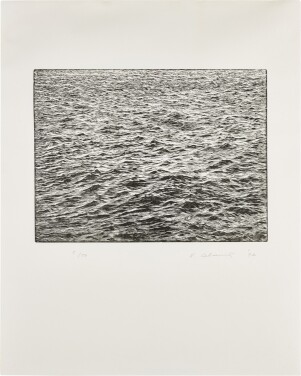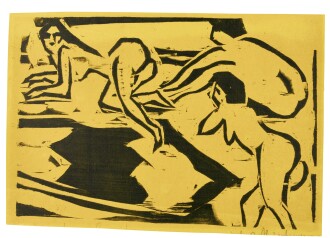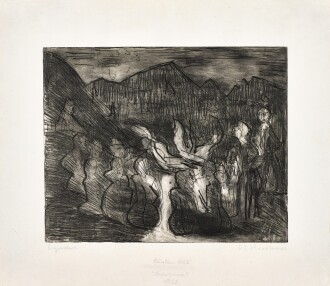S otheby’s London’s Prints & Multiples auction will celebrate the work of avant-garde printmakers from the turn of the 20th century to the present day. With a focus on modern and contemporary editioned works, the auction explores the evolution of ground-breaking artistic movements from Cubism to Expressionism to Pop and Street Art. Highlights of this diverse sale include Henri Matisse’s hypnotic Jazz portfolio and M. C. Escher’s rare panoramic woodcut Metamorphosis II. These Modern masterpieces are accompanied in the auction by several of Andy Warhol’s most celebrated prints, including the complete Endangered Species portfolio, Chanel and Queen Elizabeth II of the United Kingdom, and important groups of prints by Contemporary masters Jean-Michel Basquiat and Stik.
Auction Highlights
Tour the Exhibition
Andy Warhol, Endangered Species
Andy Warhol’s Endangered Species is a set of ten screenprints depicting animals at high risk of extinction: the Siberian Tiger, the Elephant, Grevy’s Zebra, the Black Rhinoceros, the Orangutan, the Bighorn Ram, the Giant Panda, the Pine Barrons Tree Frog, the San Francisco Silverspot butterfly and the Bald Eagle (the latter has since been removed from the endangered species list). Warhol embarked upon this project as a result of discussions concerning ecology and beach erosion with New York gallery owners and environmental activists Ronald and Freya Feldman. Many impressions from the series were given to charities and sold at fundraising events dedicated to the preservation of the natural world.
The artist referred to his Endangered Species as ‘animals in make-up’, and they were treated in the same typical Warholian manner as his pantheon of stage and screen icons. The emotional drive behind the series is counterbalanced by a playfulness expressed in the artist’s choice of colour. Set against a bold backdrop, the majestic animals are depicted with vivid and exuberant colours that contrast starkly with the tragic plight that drove the series’ execution. This kind of duality is prevalent throughout Warhol’s work.
Henri Matisse, Jazz
This seminal artist’s book marks a creative milestone in Matisse’s later life—his pioneering use of the paper cut-out as a medium rather than a compositional tool. Jazz, published in 1947, is an exuberant portfolio made up of 20 pochoirs illustrating not jazz music, but the circus—with its undertones of life on the road—and the artist’s own earlier travels.
In fact, the series was once set to be titled Le Cirque. The publisher Tériade later suggested the title Jazz, which Matisse welcomed for the connection it implied between art and musical improvisation. This title also echoed Matisse’s artistic practice of constantly improvising with scissors to create new and spontaneous forms, which when placed together took on a whole new visual meaning, much like the individual parts of a jazz band. As Olivier Berggruen and Max Hollein describe in Henri Matisse: Drawing with Scissors: ‘The term probably refers to a more nebulous complex of ideas, from the rhythm of modern life to a specific existential feeling, both vital and free as well as aggressive and dangerous, constantly alternating between risk and success, mischance and luck’.

While Warhol is often considered to be synonymous with the visual culture of the 1960s, many of the artist’s most desirable graphic subjects were in fact conceived two decades later. Sotheby’s Prints & Multiples sale comprises an exciting selection of works from this fruitful period, including: $ (1) printed in a unique combination of colours (1982); the beloved, complete Endangered Species portfolio (1983); two prints from the celebrated Ads portfolio: Chanel and Paramount (1985); and Queen Elizabeth II of the United Kingdom from the ‘Royal Edition’ of Reigning Queens (1985).
Together these images demonstrate Warhol’s enduring fascination with public figures and the icons of advertising and consumer culture, whilst they reveal a more recent preoccupation with environmental and ecological issues. The works also exhibit key developments in Warhol’s practice in his later years. Whereas his dollar bills from the early 1960s were relatively monochromatic and static, $ (1) pulsates through its vivid hues and layered, erratic lines. In a similar vein, while drawing upon stock photographs to revisit familiar territory in Reigning Queens, Warhol’s chosen subjects are here stoic and strong, seemingly free from the tragedy and fragility of his 1960s muses.
Joan Miró, Série Mallorca
Jacques Dupin describes Joan Miró’s rare and important Mallorca Series as follows: ‘The series is the relentless pursuit of an engraver sure of himself, of his hand, of his eye and of his tools. The lively line, contested, manhandled, recaptured at the peak of its trembling, conjures nine figures emerging from darkness. Nine engravings wrenched from the tool, an unorthodox and criminal tool, an old nail, a wedge or iron, and specified, accentuated, situated and given colour with discrete accents of pure tone.’
The complete series, rarely seen at auction, consists of two portfolios containing 36 prints in total. Portfolio I houses 27 works in colour and black and white, which altogether survey Miro’s unique visual language. Portfolio II, comprised of nine images printed as negatives, complements the first set and demonstrates the artist’s inventiveness. Overall this late series, completed when Miro was 80 years old, demonstrates his mastery of complex techniques and a mature sense of identity as a printmaker.

Sotheby’s Prints & Multiples sale comprises the largest group of Stik editions to ever appear at auction, including several of the artist’s most important and beloved subjects: Sleeping Baby, Dancer, Beggar, Liberty and Onbu (Piggyback).
Though the figures that populate these images are made up of an economical six-line, two-dot system, they are incredibly graceful and stirring. In a 2011 interview, the artist explained: ‘Beauty is in movement… You can tell a lot about someone just by the way they’re moving their back or their eyes. There doesn’t need to be a great deal of detail there… That’s what I’m trying to capture in my work – that direct recognition. Before writing, before speech, it’s the language of the body. I think it came from trying to speak to people I don’t share a common spoken language with, just trying to find a way of conveying complex emotions without speech.'

This sale includes an exceedingly important collection of prints by Ernst Ludwig Kirchner. Comprising etchings and woodcuts from the artist’s periods in Dresden and Davos, the collection elucidates the virtuosity of Kirchner's printmaking career, which saw the artist push each technique he employed to its absolute and most powerful ends.
The extremely rare woodcuts Akte auf einem Teppich and Drei Badende, Moritzburg were created in 1910 when Kirchner was a key member of Die Brücke. In both images, Kirchner employs flat and reduced forms, a strikingly angular delineation, and a blatant eroticism—qualities that became some of the primary characteristics of early Die Brücke work. The present example of Akte auf einem Teppich is one of three known impressions of the subject, and the only one documented on canary yellow paper. Drei Badende, Moritzburg is one of only five known impressions of the subject printed in colours.
Kühe im Frühling was executed in Davos in 1933. Printed in seven colours—and one of only two known impressions in this colour combination—it is a tour-de-force in colour printmaking, which Kirchner had perfected at this relatively late stage in life.
























